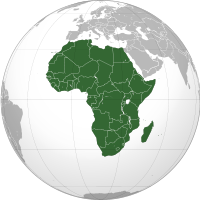Islamic Fundamentalism In Africa – Analysis
By Daniel Bodirsky
The proliferation of Islamic fundamentalist groups across Africa represents the latest iteration of the War on Terror. Much to the chagrin of the United States, Islamist militant groups from Nigeria to Somalia are increasingly coordinating their efforts and forging close links to al-Qaeda. This dossier will serve as a brief introduction to four of the most prominent Islamic fundamentalist groups operating in Africa today.
Al-Qaeda in the Islamic Maghreb (AQIM) – Algeria and the Sahel

Founded in Algeria, Al-Qaeda in the Islamic Maghreb (AQIM) is a Sunni group that is largely responsible for the renewal of Islamic insurgency in North Africa. It was previously known as the Salafist Group for Preaching and Combat, though a merger with al-Qaeda in 2006 rebranded the movement as a local chapter of al-Qaeda. AQIM’s stated goals are the overthrow of the Algerian government and the establishment of an Islamic state in its place. Despite its roots as a local insurrection tied to the Algerian Civil War of the early nineties, AQIM has become increasingly internationalized since merging with al-Qaeda. The group’s operations now extend across the Sahel, and it has attacked targets in Mauritania, Mali, Niger and Chad. AQIM has also gained notoriety for kidnapping various European tourists in North Africa. But despite these occasional reaches beyond its borders, AQIM remains a largely Algerian operation, drawing from the Kabyle and Sahrawi communities for membership. According to the head of the U.S. Africa Command (AFRICOM), AQIM is now the richest faction of al-Qaeda.
Boko Haram – Nigeria
Formed in Nigeria’s Muslim-majority north, Boko Haram has risen to become the country’s most potent security threat. It gained international attention following sectarian violence in July 2009 that left more than a thousand people dead. The group espouses a virulent anti-secular/anti-Western agenda, such that the very name “Boko Haram” means “Western education is sinful” in the Hausa language. This organization is thought to have been responsible for a bevy of deadly anti-Christian bombings throughout Nigeria. Boko Haram’s hardline ideology opposes any interaction with the West, and rejects modern science on the grounds that it is contradictory to Islamic teaching. Alongside AQIM and Somalia’s al-Shabab, Boko Haram was identified by AFRICOM as one of three major militant groups in Africa specifically targeting Westerners. AQIM has been singled out as a major source of Boko Haram’s funding.
Al-Shabab – Somalia and the Horn of Africa
Out of Somalia’s unending strife comes al-Shabab, al-Qaeda’s franchise in the Horn of Africa. Al-Shabab rose out of the ashes of the Islamic Courts Union (ICU), which had once been the principle contender against the Transitional Federal Government (TFG). Joint Ethiopian-TFG operations dealt a devastating blow to the ICU in late 2006, leading to a split and the subsequent rise of al-Shabab. The group became officially affiliated with al-Qaeda in 2007. Al-Shabab currently controls large swaths of territory in southern Somalia, though it has recently suffered setbacks in the form of advances by TFG and African Union. As of June 2012, al-Shabab is estimated to field between 4000 and 6000 fighters. With the 2010 Kampala bombings and cross-border attacks in Kenya, al-Shabab is thought to be widening its scope, and thus may come to represent a dire threat to the regional stability of East Africa. Fighters are drawn not only from Somali clans, but also include foreign volunteers from Kenya, Yemen, Pakistan, the Gulf countries, and Western states. Owing to its hardline ideology, al-Shabab’s list of enemies is extensive, including the TFG, the United States, the African Union and Kenya.
Ansar Dine – Mali
The youngest of the four major Islamist groups, Ansar Dine emerged from obscurity in early 2012 to seize control of northern Mali. Together with the Tuareg rebel group National Movement for the Liberation of Azawad (MLNA), Ansar Dine took advantage of a coup in March 2012 to capture Azawad, Mali’s vast northern region. The group then set about implementing Sharia law in regions under its control. While the unlikely alliance between the Islamist Ansar Dine and the secular MLNA succeeded in evicting government forces from Azawad, their friendship proved to be short-lived. Ansar Dine’s goal of establishing an Islamic state has put it at odds with the secular MLNA, who seek an independent homeland for the Tuareg people in Azawad. Tensions culminated with the Battle of Gao on June 28, which saw the Islamists wrest control of northern Mali’s major cities from the MLNA. Amidst the resulting international outcry, Ansar Dine embarked on a campaign to destroy ancient Muslim shrines in the city of Timbuktu. The rise of both Ansar Dine and the MLNA is linked to the aftermath of the Libyan Civil War, both having been armed in large part with weapons looted from Gaddafi’s storehouses.
Daniel Bodirsky is a contributor to Geopoliticalmonitor.com
